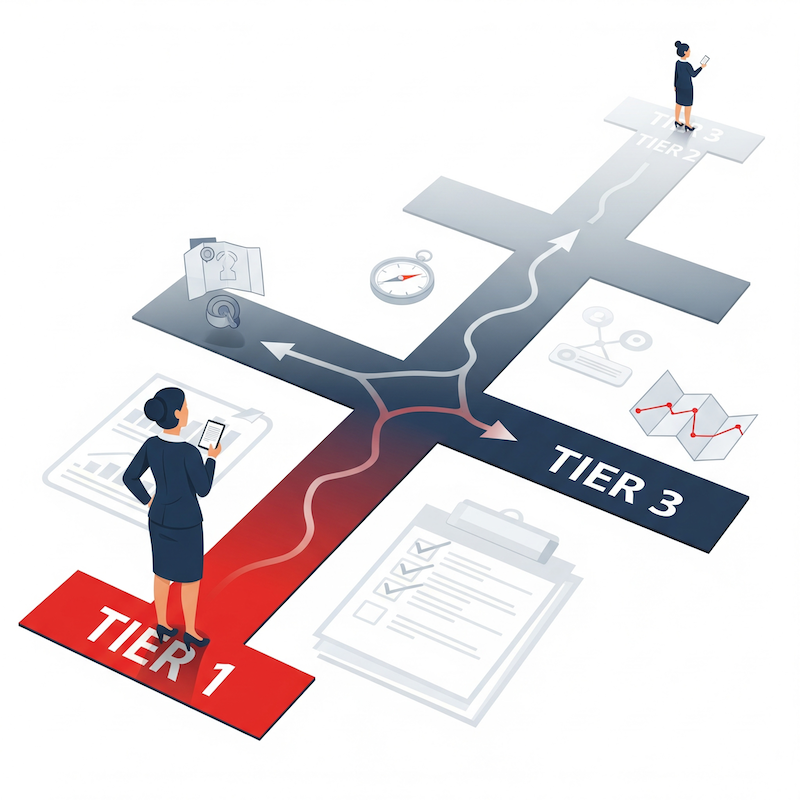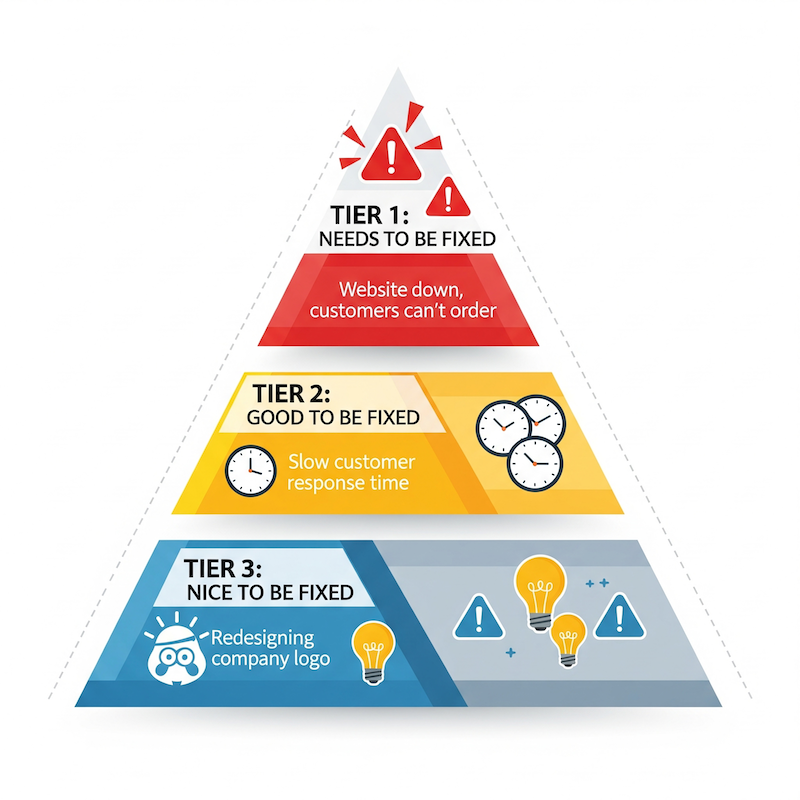How to Identify and Solve Tier 1 Problems: A Bootstrap Entrepreneur's Guide to Product Success
A Case study from my own business on how to validate a new business idea to achieve product market fit

Summary
Successful product launches depend on solving genuine Tier 1 problems—urgent issues customers must address rather than nice-to-have solutions. This guide walks through a systematic approach to problem identification, solution validation, and customer qualification that can save entrepreneurs time and resources while increasing success rates.
Key Points
- Define problems in one clear sentence before developing solutions
- Categorize customer problems as must-fix, should-fix, or could-fix priorities
- Study existing customer workarounds to understand real pain points
- Align new solutions with 80% of current workflows for easier adoption
- Focus only on customers showing genuine interest and budget availability
Key Takeaways
- Most failed product launches target Tier 3 problems disguised as priorities
- Customers already solving problems creatively indicate genuine Tier 1 needs
- Budget discussions separate serious prospects from polite but uncommitted ones
The entrepreneurial journey overflows with exciting ideas. Every conversation, every industry observation, every late-night brainstorm can spark what feels like the next breakthrough solution. Yet most of these promising concepts fail not because they lack merit, but because they solve the wrong problems.
After years of launching services within my security business and witnessing countless startup failures, I've learned a fundamental truth: success isn't about having great solutions—it's about solving genuine Tier 1 problems that customers desperately need fixed.
The Solution-First Trap
Last year, I became captivated by video analytics technology for security systems. The technology was impressive: automated threat detection, reduced manpower costs, enhanced monitoring capabilities. I spent months perfecting the technical details and crafting compelling presentations about improved security outcomes.
When I finally pitched this "revolutionary" solution to existing customers, reality hit hard. While they acknowledged the technology's potential, their real concern was securing budget approval for basic CCTV camera procurement. Their priority was reducing annual security expenses, not adding sophisticated new systems.
This experience taught me about the "solution looking for a problem" trap. Many entrepreneurs, especially in the AI space, fall into this pattern. They develop exciting technology first, then search for problems it might solve. This backwards approach explains why so many well-funded startups struggle to find paying customers.
The antidote is simple but difficult: start with the problem, not the solution. 
Step 1: Define the Problem in One Sentence
Before exploring any business idea, force yourself to articulate the exact problem you're solving in a single, clear sentence. This constraint prevents the vague problem statements that lead to unfocused solutions.
For my video analytics project, my initial problem statement was: "Security systems need better monitoring capabilities." This was too broad and solution-oriented.
After customer conversations, I refined it to: "Organizations struggle to procure necessary security equipment within tight budget constraints." This clearer problem statement led to entirely different solution approaches.
Your problem statement should:
- Focus on the customer's perspective, not your solution's capabilities
- Use specific language rather than industry jargon
- Describe a situation that causes real frustration or loss
- Avoid any mention of your proposed solution
If you can't articulate the problem in one sentence, you don't understand it well enough to build a solution.
Step 2: Determine if It's a Tier 1 Problem
Not all problems deserve equal attention. Customer problems fall into three categories:
Tier 1: Needs to be Fixed
These problems cause immediate pain, lost revenue, or operational disruption. Customers actively seek solutions and allocate budget to address them. Examples include critical system failures, compliance violations, or significant cost overruns.
Tier 2: Good to be Fixed
These problems create inefficiencies or minor frustrations. Customers acknowledge them but can operate normally without immediate solutions. They might address these during planned upgrades or when budget allows.
Tier 3: Nice to be Fixed
These are inconveniences or optimization opportunities. Customers mention them in surveys but rarely prioritize them for action. They're often academic problems that sound important but don't drive purchasing decisions.
My CCTV procurement financing solution addressed a Tier 2 or 3 problem. While organizations wanted better equipment financing, they could function with existing systems. Budget constraints were frustrating but not business-critical.
Only Tier 1 problems generate the urgency needed for customers to change their behavior, allocate resources, and adopt new solutions. 
Step 3: Study Existing Customer Solutions
When I shifted focus to the real Tier 1 problem—theft control and unauthorized access prevention—I discovered customers were already implementing creative workarounds. They developed detailed protocols, implemented strict access controls, and created manual monitoring systems.
These existing solutions revealed several insights:
- The problem was genuine (customers invested time and effort addressing it)
- Current approaches had limitations (creating opportunities for improvement)
- Customers preferred process-based solutions they could control and modify
Understanding existing solutions helps you:
- Validate that customers consider this a real problem worth solving
- Identify specific pain points in current approaches
- Design solutions that complement rather than replace existing workflows
- Avoid proposing changes that seem too radical or risky
Customers who haven't attempted any solution to a problem probably don't consider it worth solving.
Step 4: Address Integration Concerns
The biggest barrier to adoption isn't technical—it's operational. Customers resist solutions that require significant changes to established workflows, even when those solutions offer clear benefits.
My initial video analytics proposal failed because it required completely new operational procedures. Security teams would need training, existing protocols required rewriting, and integration with current systems seemed complex.
Successful solutions follow the 80/20 rule: maintain 80% compatibility with existing workflows while offering 20% unique value. This approach reduces adoption friction and allows customers to experience benefits without major operational disruption.
When presenting new solutions:
- Map how your solution fits into existing processes
- Identify which current procedures remain unchanged
- Highlight specific improvements without requiring system overhauls
- Offer pilot programs that demonstrate integration ease
Risk-averse customers need confidence that your solution enhances rather than disrupts their operations.
Step 5: Qualify Budget and Genuine Interest
The most telling indicator of customer commitment isn't enthusiasm—it's budget discussion. Customers who avoid pricing conversations signal that they're not serious buyers, regardless of their expressed interest.
During my video analytics project, dozens of customers praised the concept and requested detailed proposals. However, only two engaged in serious pricing discussions. These were the only customers who ultimately purchased solutions.
This pattern reveals a crucial qualification criterion: genuine prospects discuss money. They ask about pricing structures, payment terms, and budget requirements. They treat your solution as a business investment, not an interesting concept.
Focus your limited time and resources on prospects who:
- Ask detailed pricing questions early in discussions
- Discuss budget allocation timelines and approval processes
- Compare your solution's costs to current problem expenses
- Show urgency in implementation timelines
Polite interest without budget discussion indicates a Tier 2 or 3 problem, not genuine purchasing intent.
The Customer Workaround Test
The most reliable indicator of a Tier 1 problem is customer workarounds. When customers create manual processes, hire additional staff, or implement temporary fixes to address an issue, they're demonstrating genuine need.
In my security business, customers who eventually purchased video analytics solutions were already:
- Manually monitoring multiple camera feeds
- Hiring extra personnel for coverage gaps
- Creating complex patrol schedules to compensate for blind spots
- Implementing elaborate incident response procedures
These workarounds represented significant hidden costs and operational complexity. Our solution didn't just add new capabilities—it replaced expensive, inefficient processes customers had already built.
Look for customers who have:
- Dedicated staff time to manual workarounds
- Implemented complex procedures to address the problem
- Allocated budget to partial solutions or temporary fixes
- Created systems they acknowledge are inefficient but necessary
These behaviors indicate Tier 1 problems worth solving.

Building Your Problem Validation Process
Successful entrepreneurs develop systematic approaches to problem validation before investing in solution development. Here's a practical framework:
Week 1-2: Problem Discovery
- Conduct 10-15 customer interviews focusing only on problems, not solutions
- Ask about current pain points, workarounds, and unsuccessful attempts at solutions
- Identify patterns in problem descriptions and severity levels
Week 3-4: Problem Prioritization
- Return to customers with refined problem statements
- Ask them to rank problems by urgency, frequency, and impact
- Identify which problems they're actively working to solve
Week 5-6: Solution Validation
- Present high-level solution concepts (not detailed implementations)
- Gauge interest through budget and timeline discussions
- Test willingness to participate in pilot programs
This process prevents the months of wasted effort I experienced building solutions for non-existent or low-priority problems.
Common Validation Mistakes
Mistake 1: Asking Leading Questions "Would you like a solution that reduces costs by 30%?" always gets positive responses. Instead ask: "What are your biggest operational challenges right now?"
Mistake 2: Accepting Polite Interest as Validation Customers will rarely tell you directly that your idea is bad. Look for concrete actions like budget allocation or pilot participation, not verbal encouragement.
Mistake 3: Solving Your Own Problems Just because you experience a problem doesn't mean it's a market opportunity. Validate that enough customers share your problem and consider it worth solving.
Mistake 4: Underestimating Switching Costs Customers must believe your solution's benefits significantly outweigh the costs and risks of changing their current approach.
Frequently Asked Questions
How do I know if I'm talking to the right customers during validation?
Focus on customers who currently experience the problem and have authority to purchase solutions. Avoid gatekeepers or users who can't influence buying decisions. Look for customers who mention budget constraints, approval processes, or implementation timelines—these indicate decision-making authority.
What if customers say they need my solution but won't discuss pricing?
This typically indicates a Tier 2 or 3 problem. Customers with genuine Tier 1 problems want to understand costs because they're actively seeking solutions. Continue validation with other prospects while keeping these customers informed of your progress.
How many customer conversations should I have before proceeding?
Aim for at least 10-15 interviews with potential customers who fit your target profile. Look for consistent patterns in problem descriptions, current solutions, and urgency levels. If you're not seeing clear patterns after 15 conversations, your problem definition may need refinement.
Can I validate problems through surveys instead of individual conversations?
Surveys can provide quantitative validation but miss the nuanced insights that individual conversations reveal. Use surveys to confirm patterns discovered through interviews, not as your primary validation method. The depth of understanding from conversations is crucial for solution design.
What if I discover my problem isn't Tier 1 for most customers?
This is valuable learning that saves significant time and resources. Either refine your problem statement based on customer feedback or pivot to addressing genuine Tier 1 problems you've discovered. Many successful businesses emerged from failed initial concepts.
How do I know if I'm talking to the right customers during validation?
Focus on customers who currently experience the problem and have authority to purchase solutions. Avoid gatekeepers or users who can't influence buying decisions. Look for customers who mention budget constraints, approval processes, or implementation timelines—these indicate decision-making authority.
What if customers say they need my solution but won't discuss pricing?
This typically indicates a Tier 2 or 3 problem. Customers with genuine Tier 1 problems want to understand costs because they're actively seeking solutions. Continue validation with other prospects while keeping these customers informed of your progress.
How many customer conversations should I have before proceeding?
Aim for at least 10-15 interviews with potential customers who fit your target profile. Look for consistent patterns in problem descriptions, current solutions, and urgency levels. If you're not seeing clear patterns after 15 conversations, your problem definition may need refinement.
Can I validate problems through surveys instead of individual conversations? Surveys can provide quantitative validation but miss the nuanced insights that individual conversations reveal. Use surveys to confirm patterns discovered through interviews, not as your primary validation method. The depth of understanding from conversations is crucial for solution design.
What if I discover my problem isn't Tier 1 for most customers? This is valuable learning that saves significant time and resources. Either refine your problem statement based on customer feedback or pivot to addressing genuine Tier 1 problems you've discovered. Many successful businesses emerged from failed initial concepts.
How do I balance building relationships with customers versus qualifying them quickly?
Be transparent about your validation process. Explain that you're researching market needs before building solutions. Most customers appreciate this approach and respect entrepreneurs who prioritize solving real problems over pushing predetermined solutions.
Definition of Key Terms
- Tier 1 Problem: Critical issues that customers must solve immediately because they cause significant operational pain, revenue loss, or compliance risks
- Customer Workaround: Manual processes, temporary fixes, or suboptimal solutions customers implement to address problems they can't solve with available tools
- Problem Validation: The process of confirming that potential customers experience specific problems and consider them worth solving before developing solutions
- Solution-First Trap: The common entrepreneurial mistake of developing solutions before validating that customers have genuine problems worth solving